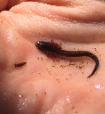Eastern Lesser Siren (Siren intermedia intermedia)
Description: This species averages 8 5/8 inches in length, with extremes of 5 9/32 inches and 13 5/8 inches recorded. The body is long, slender and eel-like. The head is long and widens just above the gills. The eyes are small and without lids. The mouth is small, crescentic, subterminal, and slightly overhung by the upper jaw. Nostrils are small and slit-like and placed at the ventrolateral angles of the snout. There are 31-34 costal grooves. The tail is broadly oval in cross section at the base, becoming more strongly compressed toward the tip. The dorsal tail fin arises as a low ridge above the vent, but immediately thins and continues to the tip. Only the forelegs are present. There are 4 toes on each front foot. The color varies from deep brown to olive-green. Many rounded black spots are scattered over the back and sides of the head, trunk, and tail. The ventral side is darker than the dorsal
Habitat: This species usually inhabits still water in cypress or pine woods. It is also found in ditches, ponds, streams or reservoirs where aquatic vegetation, debris or bottom mud and muck allow it to hide during the day.
Range: Siren i. intermedia, the eastern lesser siren, ranges from central Alabama to sourtheastern Virginia. S
Found in these States:
FL |
GA |
NC |
SC
Diet: Feeding is primarily nocturnal. Lesser sirens consume a variety of invertebrate prey, including small crustaceans, insect larvae, snails, and annelid worms. It was found that small crustaceans accounted for up to 87%, and snails and sphaeriid clams accounted for ~10%, of the total number of food items eaten.
Reproduction: Mating behavior of sirens has not been reported. Numerous attempts to breed sirens in captivity have failed. Sirens will breed in captivity providing there is sufficient vegetation or debris in which to build their nests. Fertilization is concurrent with oviposition. In South Carolina, it has been found that oviposition occurred primarily in February–March, but also possibly in January and April. Oviposition occurred from late December to March in south-central Florida. A nest of eggs accompanied by an adult lesser siren was found in early April in Arkansas.
Egg deposition sites - Egg masses accompanied by females or adults of undetermined sex have been found at the base of rooted macrophytes, in fibrous mats of water hyacinth roots, and in muddy depressions or plant debris in pond bottoms. Clutch size - The number of eggs produced in a season is highly variable, ranging from about 200–500 or more. The incubation period lasts 1.5–2.5 months, based on the first appearance of small larvae in seasonal samples.
Status: Listed as Least Concern in view of its relatively wide distribution, tolerance of a degree of habitat modification and presumed large population.
»» Kingdom: Animalia - Animals
»» Phylum: Chordata - Chordates
»» Subphylum: Vertebrata - Vertebrates
»» Class: Amphibia - (Amphibians)
»» Order: Caudata - Salamanders
»» Family: Sirenidae - Sirens
»» Genus: Siren
»» Species: Siren intermedia - Lesser Siren
»» Subspecies: Siren intermedia intermedia - Eastern Lesser Siren
This article uses material from the Wikipedia article "Lesser Siren", which is released under the Creative Commons Attribution-Share-Alike License 3.0. Content may have been omitted from the original, but no content has been changed or extended.
|








